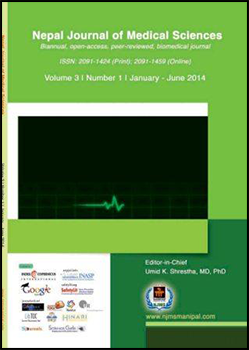Study of Supracondylar Fracture of Distal Humerus in Children and Its Management with Lateral K-Wire Fixation
DOI:
https://doi.org/10.3126/njms.v3i1.10356Keywords:
Fracture distal humerus, lateral pinning, supracondylar fractureAbstract
Background: Supracondylar fracture is one of the common fractures in children. There are different methods of treatment. This study was undertaken to evaluate the results of lateral k wire fixation for the displaced supracondylar fracture of distal humerus in children.
Methods: There were 32 children with displaced Supracondylar fracture, treated with closed reduction and percutaneous lateral K-wires fixation. Clinical and radiological assessments were done and outcomes were assessed on basis of Flynn criteria and data were analyzed in SPSS 16. P value <0.05 was considered significant.
Result: The mean age of patients was 6.41 ± 2.37 with boys predominant. There were excellent result of 24(75%) good result 5(15%) regarding carrying angle and regarding range of motion 25 (78%) excellent and4(12%) good result. There were more than 90% patients with excellent to good result. Comparing the Baumann’s angle intra-operatively and at the final follow up, there was no statistically significant difference with P value > 0.05.
Conclusion: Lateral pinning with 2 and if necessary 3 k wires for proper stabilization and idea configuration of divergent to hold medial and lateral column is the ideal treatment of supracondylar fracture without risk of iatrogenic nerve injury.
Nepal Journal of Medical Sciences | Volume 03 | Number 01 | January-June 2014 | Page 38-43
Downloads
Downloads
Published
How to Cite
Issue
Section
License
Copyright © by Nepal Journal of Medical Sciences. The ideas and opinions expressed by authors of articles summarized, quoted, or published in full text in this Journal represents only opinions of authors and do not necessarily reflect the official policy of Nepal Journal of Medical Sciences or the institute with which the author(s) is (are) affiliated, unless so specified.




